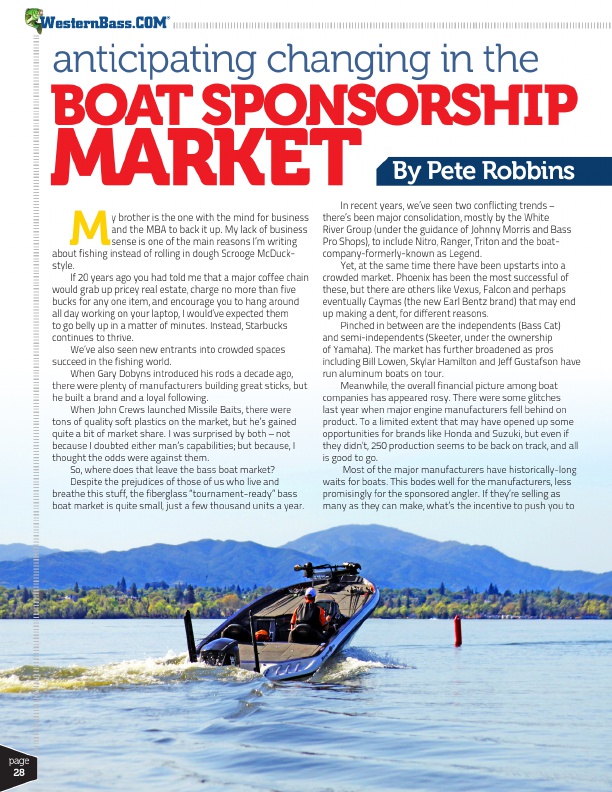
®
anticipating changing in the
BOAT SPONSORSHIP
MARKET
By Pete Robbins
M
y brother is the one with the mind for business
and the MBA to back it up. My lack of business
sense is one of the main reasons I’m writing about fishing instead of rolling in dough Scrooge McDuck-
style.
If 20 years ago you had told me that a major coffee chain
would grab up pricey real estate, charge no more than five
bucks for any one item, and encourage you to hang around
all day working on your laptop, I would’ve expected them
to go belly up in a matter of minutes. Instead, Starbucks
continues to thrive.
We’ve also seen new entrants into crowded spaces
succeed in the fishing world.
When Gary Dobyns introduced his rods a decade ago,
there were plenty of manufacturers building great sticks, but
he built a brand and a loyal following.
When John Crews launched Missile Baits, there were
tons of quality soft plastics on the market, but he’s gained
quite a bit of market share. I was surprised by both – not
because I doubted either man’s capabilities; but because, I
thought the odds were against them.
So, where does that leave the bass boat market?
Despite the prejudices of those of us who live and
breathe this stuff, the fiberglass “tournament-ready” bass
boat market is quite small, just a few thousand units a year.
In recent years, we’ve seen two conflicting trends – there’s been major consolidation, mostly by the White River Group (under the guidance of Johnny Morris and Bass Pro Shops), to include Nitro, Ranger, Triton and the boat- company-formerly-known as Legend.
Yet, at the same time there have been upstarts into a crowded market. Phoenix has been the most successful of these, but there are others like Vexus, Falcon and perhaps eventually Caymas (the new Earl Bentz brand) that may end up making a dent, for different reasons.
Pinched in between are the independents (Bass Cat) and semi-independents (Skeeter, under the ownership of Yamaha). The market has further broadened as pros including Bill Lowen, Skylar Hamilton and Jeff Gustafson have run aluminum boats on tour.
Meanwhile, the overall financial picture among boat companies has appeared rosy. There were some glitches last year when major engine manufacturers fell behind on product. To a limited extent that may have opened up some opportunities for brands like Honda and Suzuki, but even if they didn’t, 250 production seems to be back on track, and all is good to go.
Most of the major manufacturers have historically-long waits for boats. This bodes well for the manufacturers, less promisingly for the sponsored angler. If they’re selling as many as they can make, what’s the incentive to push you to
page 28